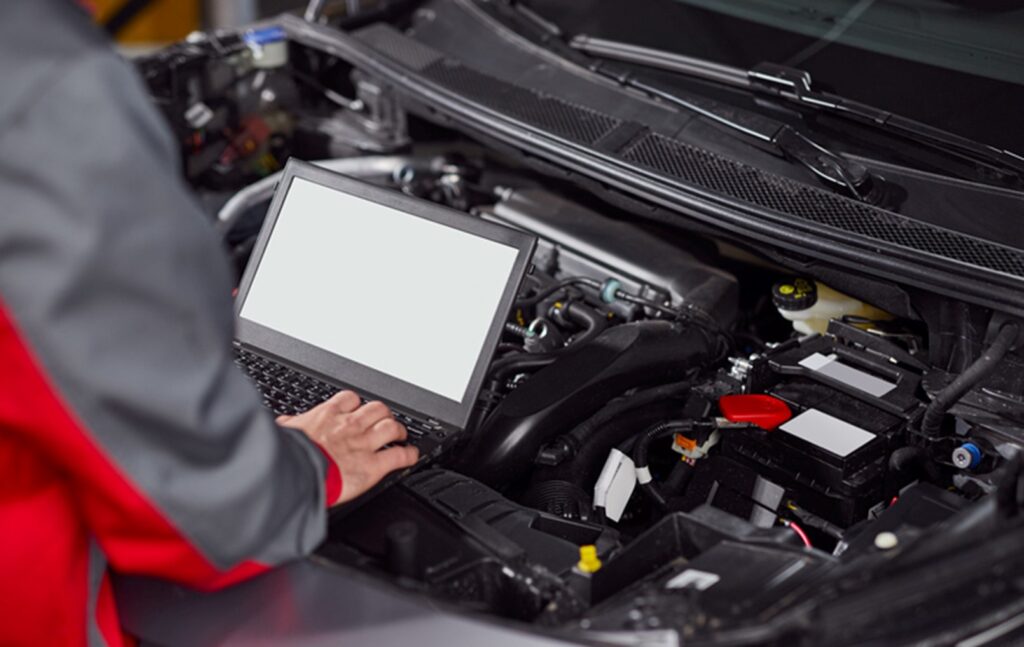Integrating Autonomous Driving in Electric Vehicles
Category : Embedded Blog
In recent years, the automotive industry has witnessed a remarkable convergence of two groundbreaking technologies: autonomous driving and electric vehicles. This fusion holds immense promise, offering a glimpse into a future where transportation is not only emission-free but also effortlessly navigated by intelligent machines. In this blog, we delve into the seamless integration of autonomous driving features in electric vehicles, exploring their current capabilities, the challenges they face, and the roadmap towards achieving full autonomy.
Current Landscape of Autonomous Driving in Electric Vehicles
Advanced Driver Assistance Systems (ADAS)
Advanced Driver Assistance Systems (ADAS) represent the initial steps towards autonomy in electric vehicles. These systems are designed to assist the driver in various tasks, enhancing safety and comfort on the road. Key features include:
- Collision Avoidance Systems: Collision avoidance systems utilize sensors such as radar and cameras to detect obstacles in the vehicle’s path. These systems can provide warnings to the driver or even intervene autonomously to prevent collisions.
- Lane Keep Assist: Lane keep assist systems utilize cameras and sensors to monitor lane markings and keep the vehicle within its lane. This feature helps prevent unintended lane departures and can provide gentle steering inputs to keep the vehicle on course.
- Adaptive Cruise Control: Adaptive cruise control systems use sensors to monitor the distance between the vehicle and other vehicles on the road. By adjusting the vehicle’s speed accordingly, adaptive cruise control can maintain a safe following distance and reduce driver fatigue during long journeys.
Level 2 and Level 3 Autonomy
Level 2 and Level 3 autonomy represent the next stage in the evolution of autonomous driving in electric vehicles. While these systems still require driver supervision, they offer more advanced
- Tesla’s Autopilot System: Tesla’s Autopilot system is perhaps the most well-known example of Level 2 autonomy in electric vehicles. Using a combination of cameras, radar, and ultrasonic sensors, Autopilot can control the vehicle’s speed, steering, and braking in certain driving conditions. However, drivers are still required to remain attentive and ready to intervene if necessary.
- General Motors’ Super Cruise: General Motors’ Super Cruise system is another prominent example of Level 2 autonomy. Super Cruise utilizes a combination of lidar mapping, cameras, and sensors to enable hands-free driving on compatible highways. The system includes a driver attention monitoring system to ensure that the driver remains engaged and ready to take control if needed.
- Audi’s Traffic Jam Pilot: Audi’s Traffic Jam Pilot system is an example of Level 3 autonomy, which allows for even greater automation in certain driving scenarios. Traffic Jam Pilot can take over driving duties in stop-and-go traffic situations, allowing the driver to relaxfor a while. . However, the driver must still be prepared to resume control when exiting the traffic jam.
Challenges on the Horizon
Technical Hurdles
Despite significant advancements, autonomous driving in electric vehicles still faces several technical challenges that must be overcome:
- Sensor Integration and Fusion: Integrating data from various sensors, including cameras, radar, lidar, and ultrasonic sensors, presents a significant challenge. Ensuring seamless communication and data fusion between these sensors is crucial for accurate perception and decision-making.
- Real-time Data Processing: Autonomous driving systems require rapid processing of vast amounts of sensor data to make split-second decisions. Achieving real-time data processing capabilities while minimizing latency is essential for safe and efficient autonomous driving.
- High-definition Mapping: High-definition mapping is essential for autonomous vehicles to navigate complex environments accurately. Developing and maintaining detailed maps with up-to-date information on road conditions, lane markings, and traffic signals is a challenging task that requires collaboration between automakers, mapping companies, and regulatory authorities.
Regulatory and Legal Frameworks
The widespread adoption of autonomous driving in electric vehicles is also contingent on the development of robust regulatory and legal frameworks:
- Liability and Insurance: Determining liability in the event of accidents involving autonomous vehicles remains a complex legal issue. Clear guidelines and regulations are needed to establish liability standards and ensure that appropriate insurance coverage is in place.
- Compliance with Safety Standards: Autonomous driving systems must adhere to stringent safety standards to ensure the protection of occupants and other road users. Establishing standardized testing procedures and certification processes is essential to verify the safety and reliability of these systems.
- International Harmonization: Achieving international harmonization of regulations and standards is critical for the global deployment of autonomous driving technology. Collaboration between governments, regulatory agencies, and industry stakeholders is needed to harmonize legal frameworks and facilitate cross-border operations.
Ethical Considerations
The integration of autonomous driving features in electric vehicles also raises important ethical considerations:
- Decision-making Algorithms: Autonomous vehicles must make complex decisions in situations where ethical dilemmas arise, such as potential collisions with pedestrians or other vehicles. Developing ethical decision-making algorithms that prioritize safety while considering moral and legal implications is a significant challenge.
- Passenger Safety vs. Pedestrian Welfare: Autonomous driving systems must strike a balance between prioritizing the safety of vehicle occupants and minimizing harm to pedestrians and other vulnerable road users. Resolving conflicts between these priorities requires careful consideration of ethical principles and societal values.
- Privacy Concerns: Autonomous vehicles collect vast amounts of data about their surroundings and occupants, raising concerns about privacy and data security. Implementing robust data protection measures and transparent data handling policies is essential to address these concerns and maintain consumer trust.
Roadmap Toward Fully Autonomous EVs
Enhanced Sensor Technology
Continued advancements in sensor technology are essential for achieving full autonomy in electric vehicles
- Lidar, Radar, and Cameras: Improvements in lidar, radar, and camera technology will enhance the perception capabilities of autonomous vehicles, enabling them to detect and respond to a wider range of environmental conditions.
- Advancements in Artificial Intelligence: Advances in artificial intelligence, particularly in machine learning and neural networks, will enable autonomous vehicles to make more sophisticated decisions based on complex data inputs.
- Sensor Fusion Techniques: Integrating data from multiple sensors using advanced fusion techniques will improve the reliability and accuracy of autonomous driving systems, reducing the risk of errors and false positives.
Infrastructure Development
Building the necessary infrastructure to support autonomous driving is another crucial aspect of the roadmap:
- V2X Communication Systems: Vehicle-to-everything (V2X) communication systems enable vehicles to communicate with each other and with infrastructure elements such as traffic lights and road signs. Implementing V2X technology will enhance the safety and efficiency of autonomous driving by providing vehicles with real-time information about their surroundings.
- Dedicated Autonomous Lanes: Designating dedicated lanes or corridors for autonomous vehicles can help mitigate traffic congestion and improve the overall flow of traffic. These lanes can be equipped with special infrastructure elements to support autonomous driving, such as wireless charging stations and vehicle detection sensors.
- Smart Cities Initiatives: Smart cities initiatives aimed at integrating autonomous vehicles into urban environments are essential for realizing the full potential of autonomous driving technology. These initiatives involve collaboration between government agencies, urban planners, and technology companies to develop intelligent transportation systems that prioritize safety, efficiency, and sustainability.
Collaborative Efforts
Collaboration between industry stakeholders, research institutions, and government agencies is critical for driving progress towards fully autonomous electric vehicles:
- Industry Partnerships: Collaborative partnerships between automakers, technology companies, and suppliers facilitate the sharing of knowledge, resources, and expertise necessary for developing and deploying autonomous driving technology.
- Research and Development Consortia: Research and development consortia bring together academia, industry, and government partners to tackle complex technical challenges and accelerate innovation in autonomous driving technology.
- Government Support and Funding: Government support and funding play a crucial role in advancing autonomous driving technology through research grants, tax incentives, and regulatory initiatives. Investing in infrastructure upgrades, research and development, and public-private partnerships can help spur innovation and accelerate the adoption of autonomous electric vehicles.
The Future Outlook
Accelerating Adoption Rates
Despite the challenges ahead, the adoption of autonomous driving in electric vehicles is expected to accelerate in the coming years:
- Consumer Acceptance and Trust: As autonomous driving technology matures and becomes more widespread; consumers are likely to become more comfortable with the idea of relinquishing control to autonomous systems. Building trust through transparent communication, rigorous testing, and real-world demonstrations is essential for gaining widespread acceptance.
- Economic Viability: The economic benefits of autonomous driving, including increased safety, efficiency, and productivity, are expected to drive adoption among businesses and consumers alike. As the cost of autonomous technology decreases and the value proposition becomes more compelling, demand for autonomous electric vehicles is likely to grow.
- Environmental Impact: Electric vehicles already offer significant environmental benefits compared to traditional internal combustion engine vehicles, and the integration of autonomous driving technology has the potential to further enhance their sustainability. By optimizing driving behaviour, reducing traffic congestion, and enabling more efficient use of energy, autonomous electric vehicles can help mitigate the environmental impact of transportation.
Mobility as a Service (MaaS)
The rise of mobility as a service (MaaS) models is poised to transform the way we think about transportation:
- Shared Autonomous Fleets: Shared autonomous fleets operated by transportation network companies (TNCs) offer a convenient and cost-effective alternative to private car ownership. By leveraging autonomous technology, these fleets can provide on-demand mobility services that are more efficient and accessible than traditional transportation options.
- Integration with Public Transit: Integrating autonomous vehicles with existing public transit systems can improve the overall efficiency and accessibility of urban transportation networks. By providing first-mile and last-mile connectivity to transit hubs, autonomous vehicles can help bridge the gap between public transit and final destinations.
- Last-mile Solutions: Autonomous electric vehicles are well-suited for providing last-mile solutions in urban and suburban areas where access to public transportation is limited. By offering shared rides, delivery services, and micro-transit options, autonomous vehicles can enhance mobility and reduce congestion in densely populated areas.
Socio-economic Implications
The widespread adoption of autonomous electric vehicles will have far-reaching socio-economic implications:
- Job Displacement and Reskilling: The transition to autonomous vehicles is expected to disrupt traditional employment sectors such as transportation and logistics. However, it also presents opportunities for new job creation in areas such as vehicle maintenance, software development, and fleet management. Investing in education and workforce development programs is essential to ensure that workers are equipped with the skills needed for the jobs of the future.
- Urban Planning and Design: Autonomous vehicles have the potential to reshape urban landscapes by reducing the need for parking infrastructure, alleviating traffic congestion, and reclaiming space for pedestrian and green areas. Urban planners and policymakers must proactively anticipate these changes and adapt existing infrastructure and zoning regulations to accommodate autonomous mobility.
- Accessibility and Equity: Ensuring equitable access to autonomous electric vehicles is essential for addressing transportation inequalities and improving quality of life for all residents. Initiatives such as affordable ride-sharing services, paratransit programs for individuals with disabilities, and community-driven transportation solutions can help ensure that autonomous mobility benefits everyone, regardless of income or ability.
Conclusion
As autonomous driving technology continues to evolve, its integration with electric vehicles heralds a transformative era in transportation. While challenges abound, from technical complexities to ethical dilemmas, concerted efforts across industries and regulatory bodies are paving the way toward a future where fully autonomous electric vehicles redefine the concept of mobility. By navigating these challenges with innovation and collaboration, we can steer toward a safer, greener, and more efficient transportation landscape for generations to come.
























